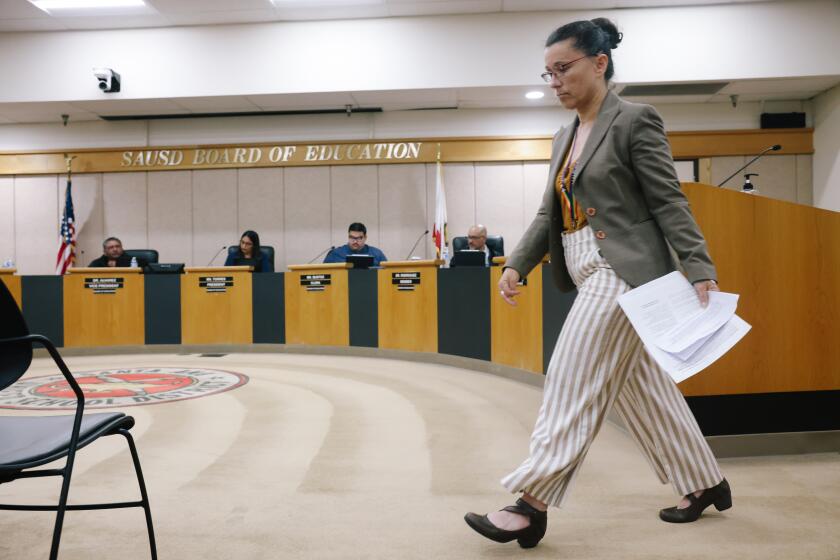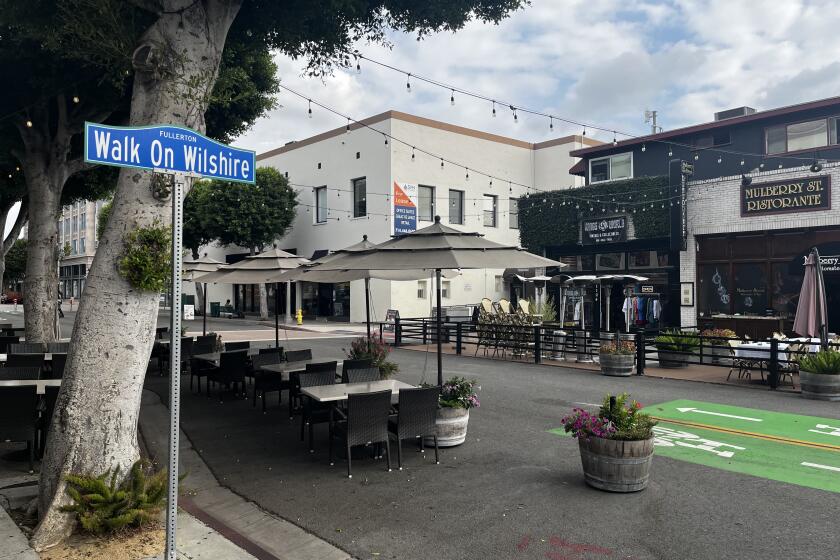A rare artifact is returned to daughters of a Vietnam War hero at the ‘Life Before ’75’ exhibition in Little Saigon
- Share via
Cathy Pham Zotti and her sister, Lyly Nguyen, had a two-part goal in going to “My Việt Heritage Exhibition — Life Before ’75” in Westminster. They wanted to learn more about their war hero father’s military service and a homeland they barely remembered.
Glass cases containing newspapers, magazines, movie posters, sheet music, books, art, military regalia and other rare memorabilia from the former South Vietnam filled the space at the Nguoi Viet Daily News headquarters.
About 1,200 people attended the March 23 and 24 event organized by Westminster’s My Viet Heritage group and Drs. Alan Tran and Thomas Quach. Attendees included Vietnamese American actress Kieu Chinh and American actor Tucker Smallwood, a Vietnam War veteran.
“What is amazing is that these artifacts still exist,” said Tran. “After the Fall of Saigon in 1975, most, if not all of [the] artifacts like these were burned, destroyed or forbidden. For a lot of the South Vietnamese, we had to leave everything to start a new life abroad.”
That was the case for Zotti and Nguyen when their family fled Vietnam by boat the night before the fall. They survived due to the ingenuity of their father, Hung Van Pham, whose military training saved their lives and dozens of others.
Pham, who died in 2015, was a lieutenant commander in the South Vietnamese navy during the war and earned a Bronze Star with a “V” for valor from the U.S. Armed Forces — a rare honor for foreign servicemen.
But Zotti and Nguyen had no pictures of their father’s military experience and knew little of his accomplishments. That is until Richard Crowe got in touch and met with them at the exhibition.
Crowe, a former lieutenant in the U.S. Navy, served as a wartime advisor on South Vietnamese ocean-going ships, two of which Pham commanded in 1970 and 1971. The men developed a friendship, talking during the long hours spent patrolling the Vietnam coast and South China Sea.
“He was a bigger-than-life, friendly-kind-of guy,” Crowe said of Pham. “[He] spoke about his family and how anti-Communist he was. Sometimes we would be on the bridge of his ship, and we would sit and talk about the world and life, sometimes operations and specific war situations in Vietnam.”
Friendship between Vietnamese officers and their American advisors was uncommon. Crowe recalled how some advisors wouldn’t eat with their Vietnamese officers, adding that they generally kept their distance.
But Pham, Crowe said, was special. Crowe captured Pham’s vivacious personality and their shared lives at sea with his 35mm camera. He snapped Pham playing his clarinet for the crew, giving off-duty toasts and being promoted to lieutenant commander of a larger ship.
Pham also confided to Crowe how he had earned the Bronze Star: as part of the CIA-led Operation 34A, Pham had commanded a clandestine PT boat that carried out covert attacks on North Vietnamese targets, one of many that were instrumental in the Gulf of Tonkin incident in 1964.
“He played Pied Piper to the enemy and lured them into the attack,” Crowe said, adding that Pham was also victorious in sinking two, steel-hulled North Vietnamese boats.
When Pham went on a patrol in Cambodia in 1971 and Crowe was unable to join, Pham brought back gifts that Crowe treasured: a cowbell and Cambodian flag, which Pham inscribed in the corner with a kind dedication to Crowe.
After Crowe finished his 17-month tour in Vietnam, he and Pham lost touch. Crowe married his first wife in Saigon and returned to the U.S., where they had two children.
Pham fled from Vietnam with his wife and six children the night before the Fall of Saigon, utilizing his naval training to commandeer a civilian boat and navigate over 100 refugees to safety in Thailand.
Zotti and Nguyen were 5 and 8 years old, respectively.
The family immigrated to the U.S., settling in Florida. Pham worked in a liquor stockroom at night and attended Jacksonville University during the day. He went on to earn a doctorate in electrical engineering.
Forty years after he left Vietnam, Crowe began scanning slides of the pictures he had taken. Seeing Pham in many of the photos, he decided to get in touch. He tracked down Pham through a network of former South Vietnamese naval officers.
The men spoke briefly on the phone in 2012, but distance and disability prevented them from meeting. Crowe lives in Riverside County, while Pham still lived in Florida. Additionally, Pham had suffered a debilitating stroke that made communication and travel difficult.
In October 2018, Crowe tried to get in touch with Pham again, this time to send him the pictures. He was dismayed to learn that Pham had died, but was able to get in touch with Zotti and Nguyen, who live in Torrance and Huntington Beach, respectively. He sent their family over 1,000 pictures of Pham’s time in the military.
“[The pictures] reaffirmed a lot of things about my dad — that he was fun, caring and a jokester,” Zotti said.
And when Crowe met Pham’s daughters face-to-face for the first time on the day of the “Life Before ’75” exhibition, they finally learned why Pham was awarded the Bronze Star.
“He always had it hanging up at his house but never discussed why he earned it,” Zotti said. “It was a part of Dad’s life that we knew nothing about.”
Crowe also presented Pham’s children with a special gift: the lovingly inscribed Cambodian flag that their father had given him nearly 50 years before.
“I thought that they would like to have something that their father actually had and signed,” Crowe said, pausing to collect himself. “I think it’s important that societies have ways of remembering. If we don’t remember, I think we’re diminished as a people and as a nation. This [exhibition] certainly reminds the Vietnamese community and Little Saigon of their heritage and why they’re here.”
While the flag and Crowe’s pictures shed light on pieces of the past for Zotti and Nguyen, the exhibition illuminated others.
“Without it, the only knowledge I had [of South Vietnam] was through reading newspapers or what my parents told me,” Zotti said. “When you think of Vietnam, all you think about is the war. I wanted to see if there was anything beyond the war. It’s important to be able to visualize that legacy … through the memorabilia and artifacts. This [exhibition] is putting me in touch with my heritage and [showing] the struggles that my dad went through to get us here.”
Aliese Muhonen is a contributor to TimesOC.
Follow her on Twitter @AlieseMuhonen, and follow @timesocofficial for more news and features about Orange County.
All the latest on Orange County from Orange County.
Get our free TimesOC newsletter.
You may occasionally receive promotional content from the Daily Pilot.




